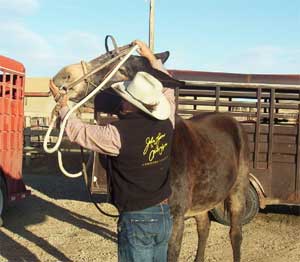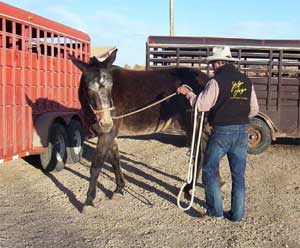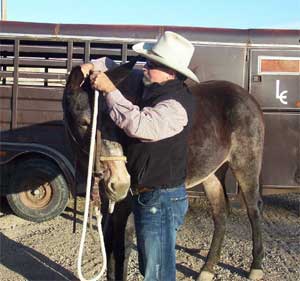|
Applying the “Replacement Concept”
By Tim Doud
Diamond Creek Mules, Cody, Wyoming
Reprinted with permission from
Mules and
More Magazine, December 2009
|
As mule owners, we are always looking for ways to improve our
mule’s performance. One of the best ways to do this is using the
“Replacement Concept.”
So, what is the “Replacement Concept?” Simply put, it is
replacing a mule’s unwanted behavior with wanted behavior. But,
the first thing we must do to achieve success with this is to
eliminate the word “don’t.”
We get in the habit of telling our mule don’t do this, don’t do
that; don’t move when I brush you, don’t walk off when I put my
foot in the stirrup, don’t bray at the other mules, etc. This
can be tiring. After finding that saying “no” to your mule does
not work, some people in frustration will jerk on the reins,
slap him, etc.
 |
|
As Tim bridles
Hannah, she pulls her head away |
We would never tell our child “no,” then hit them. If we did,
our child would stop wanting to be with us. This is the same
with our mule. If learning is not fun, or worse yet is painful,
our mules will no longer want to learn or even be around us.
If we encourage ourselves to use “don’t” enough, our mule will
start showing unwanted behaviors. He may become jumpy, run away
from you, become head shy, etc.
We must retrain ourselves to replace the unwanted behavior with
something we want our mule to do. So, if your mule begins to
walk forward and you want him to stand still; instead of saying
“don’t walk forward,” we will ask our mule to back up two steps.
Instead of “don’t bray at the other mules,” we will ask our mule
to disengage his hind quarters.
By replacing the unwanted behavior with an exercise we want, he
will, over time, stop the unwanted behavior. He will learn that
if he begins the unwanted behavior, an exercise will immediately
follow.
You will also begin to see many other benefits from using the
“Replacement Concept.” Your mule will stay calm and relaxed, not
scared or frightened. He will also become more confident and
trusting of you.
The same applies to you, the handler. You will begin to stay
calm and relaxed, not mad because your mule is performing an
unwanted behavior.
By replacing an unwanted behavior with a wanted behavior, you
will get better performance from your mule during the exercises
you are practicing. By that I mean your mule is giving you the
opportunity to teach him the exercise without being easily
distracted and performing unwanted behaviors.
So, to put the replacement concept into motion, take a look at
this example and fit it into your everyday lessons.
 |
|
When Hannah raises
her head, Tim calmly begins working on ground exercises
to replace the unwanted behavior |
If you have a mule that will not stand still, every time he
moves, spend 10 or 15 minutes asking the mule to do something.
For example, if my mule will not stand still, I will ask him to
walk forward five steps, then backwards three steps, then
disengage his hind quarters in both directions, and then move
his shoulder two steps over, etc. Soon the mule will be saying
to himself, “Just let me stand here.” You are not punishing the
mule for moving, so do not get aggressive. Calmly ask the mule
to move in the direction you want. Be sure that after the 10 or
15 minutes, your mule is calmer then when you started replacing
the unwanted behavior. If he is not, work a little longer.
You also do not want to repeat the same pattern each time. If
you do, he will memorize your pattern and begin a new unwanted
behavior. Choose exercises that he knows well and use them to
“remove” his unwanted behaviors.
Remember to always fix any problem in a safe environment. After
the mule is responding to your cues in a safe environment, move
to a place where the mule will raise his emotions a little, but
still respond to you.
The “Replacement Concept” will allow you to take a negative and
turn it into a positive. Soon your mule will always be looking
to you for directions. Once your mule is responding to your cues
consistently, go back to your original exercise. You are
building a partnership with your mule.
Soon you and your mule will always be acting positive. If your
mule shows any unwanted behavior, you will calmly say, “No
problem, do this instead.”
|
|
Tim can be reached at
www.diamondcreekmules.com, or by phone at 307/899-1089, or
email:
bliss@wavecom.net.
|
 |
|
After 10 minutes of
ground exercise, Hannah stands calmly as Tim puts the
bridle on her |
|
|
|
|
Mules and More |
December 2009 |
|
|